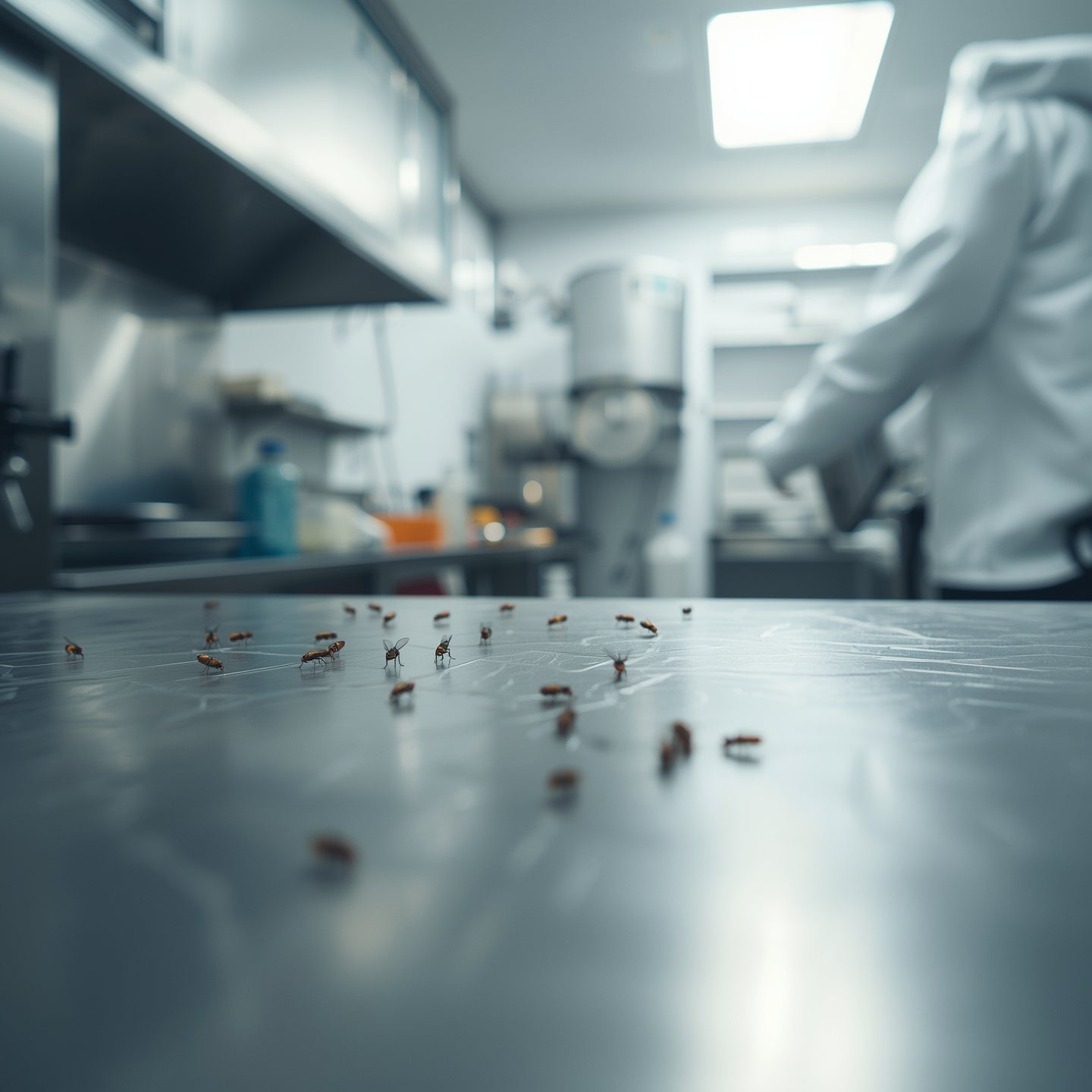Why flies in gastronomy are more than just a nuisance
Flies are among the most common hygiene pests – and are a serious risk in restaurants, large kitchens, or canteens.
Even a few animals can transmit bacteria, viruses, or fungal spores and thus contaminate food, work surfaces, or dishes.
Frequently detected pathogens:
- Salmonella
- Listeria
- E. coli bacteria
An infestation often becomes visible quickly – and this can have serious consequences:
Not only hygiene but also the trust of guests and the results of food inspections are at stake.
Therefore, prevention and quick action are crucial before an infestation spreads.

Where do the flies come from? Typical causes in kitchens and restaurants
Flies need very little to feel comfortable: warmth, moisture, and organic residues.
In kitchens, dishwashing areas, or storage rooms, they often find ideal conditions – even in well-maintained businesses.
Common causes:
- Open trash bins or food leftovers
- Contaminated drains, floor channels, or garbage rooms
- Leaky doors, windows, or ventilation shafts
- Light sources that attract insects
- Residues of organic matter in production or storage areas
Especially in summer, an infestation can develop within a few days.
Even a forgotten trash bin or a damp cloth is enough to invite flies to lay eggs.
Why chemical agents are not a sustainable solution
In kitchens or dining areas, no chemical insecticides or sprays may be used – they are
- not residue-free,
- potentially harmful to health,
- and can violate food and HACCP regulations.
Many chemical agents also only work short-term and do not combat eggs or larvae.
A truly sustainable solution must be safe, environmentally friendly, and usable during ongoing operations – without compromising food hygiene.
Chemical-free alternatives: Modern LED UV technology for kitchens and dining areas
A proven and hygienic method for fly control is the use of LED UV light systems.
These devices use targeted UV wavelengths to attract flies and securely trap them on an adhesive foil – without electric shock, shards, or toxins.
The big advantage:
They can remain in operation permanently, work quietly, are energy-efficient, and low-maintenance.
Benefits at a glance:
- ✅ Chemical-free and residue-free effect
- ✅ No odors or fumes
- ✅ Harmless to staff and guests
- ✅ Easy to clean and maintain
- ✅ Continuous operation possible even during service times
This ensures hygiene permanently – without interfering with kitchen operations or disturbing the guest area.
Practical example: UV LED systems with shatter protection for gastronomy
In many gastronomic establishments, the use of UV LED devices with shatter protection has become established.
These devices can be installed in inconspicuous places – e.g., above doors, in storage rooms, or near ventilation systems.
There, they ensure continuous monitoring of insect populations without disturbing guests.
A proven example from practice is the NK DECO 151 LED-UV device with shatter protection.
It meets the requirements of HACCP-compliant pest prevention, operates whisper-quietly, and is low-maintenance.
Thanks to the easily replaceable adhesive foil, disposal is hygienic – completely without direct contact with the insects.
(Note: The device is available in various colors and covers up to 60 m² of room area.)
Tips for hygienic handling of flies in the restaurant
Besides technical measures, operational organization is crucial to prevent fly infestations:
-
Regular cleaning:
Clean work surfaces, floor drains, and drains daily. -
Waste management:
Close waste immediately, dispose of it regularly, and clean containers. -
Check ventilation & seals:
Seal doors and windows, install airlocks or fly screens. -
Adjust light sources:
Flies are attracted to warm light – UV or LED cold light is less attractive. -
Documentation:
Document all measures in the hygiene concept (HACCP-compliant).
Conclusion: Stay fly-free – systematically and without chemicals
Flies in gastronomy are a visible sign of hygiene deficiencies – and can alert both guests and authorities.
With modern LED-UV technology combined with consistent cleaning and prevention, an infestation can be controlled permanently, silently, and environmentally friendly.
This is how your business stays hygienically safe, compliant, and welcoming – completely without chemicals.
You can find more expert articles at: Kæferling Academy Guide






